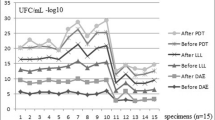Abstract
Dental caries is a multifactorial, non-communicable disease. Effective treatment options for minimally invasive removal of carious tissue include Papacarie Duo® gel and antimicrobial photodynamic therapy (aPDT). aPDT involves a combination of a light source and photosensitizer. Given that Papacarie Duo® contains a percentage of blue dye, this study aims to explore the antimicrobial potential of Papacarie Duo® when associated with a light source against Streptococcus mutans strains. The chosen light source was a low-power diode laser (λ = 660 nm, E = 3 J, P = 100 mW, t = 30 s). To assess antimicrobial capacity, planktonic suspensions of Streptococcus mutans were plated on Brain Heart Infusion Agar (BHI) to observe the formation of inhibition halos. The studied groups included methylene blue (0.005%), Papacarie Duo®, distilled water (negative control), 2% chlorhexidine (positive control), Papacarie Duo® + laser, and methylene blue (0.005%) + laser. Following distribution onto plates, each group was incubated at 37 °C for 48 h under microaerophilic conditions. Inhibition halos were subsequently measured using a digital caliper. The results showed that chlorhexidine had the greatest antimicrobial effect followed by the group of irradiated methylene blue and irradiated Papacarie Duo®. All experimental groups demonstrated antimicrobial potential, excluding the negative control group. The study concludes that Papacarie Duo® exhibits antimicrobial properties when associated with a low-power diode laser.



Similar content being viewed by others

References
Alsunbul H, Murriky A (2023) Efficacy of methylene blue and curcumin mediated antimicrobial photodynamic therapy in the treatment of indirect pulp capping in permanent molar teeth. Photodiagnosis Photodyn Ther 103598. https://doi.org/10.1016/j.pdpdt.2023.103598
Kwiatkowski S, Knap B, Przystupski D et al (2018) Photodynamic therapy – mechanisms, photosensitizers, and combinations. Biomed Pharmacother 106:1098–1107. https://doi.org/10.1016/j.biopha.2018.07.049
Rkein AM, Ozog DM (2014) Photodynamic therapy. Dermatol Clin 32:415–425. https://doi.org/10.1016/j.det.2014.03.009
Sischo L, Broder HL (2011) Photodynamic therapy in dentistry. J Dent Res 90:1264–1270
Pereira CA, Costa ACBP, Carreira CM et al (2013) Photodynamic inactivation of streptococcus mutans and streptococcus sanguinis biofilms in vitro. Lasers Med Sci 28:859–864. https://doi.org/10.1007/s10103-012-1175-3
Späth A, Leibl C, Cieplik F, Lehner K, Regensburger J, Hiller KA, Bäumler W, Schmalz G, Maisch T (2014) Improving photodynamic inactivation of bacteria in dentistry: highly effective and fast killing of oral key pathogens with novel tooth-colored type-II photosensitizers. J Med Chem 57(12):5157–68. https://doi.org/10.1021/jm4019492
Plotino G, Grande NM, Mercade M (2019) Photodynamic therapy in endodontics. Int Endod J 52:760–774. https://doi.org/10.1111/iej.13057
Atta D, Elarif A, Al Bahrawy M (2023) Reactive oxygen species creation by laser-irradiated indocyanine green as photodynamic therapy modality: an in vitro study. Lasers Med Sci 38:1–7. https://doi.org/10.1007/s10103-023-03876-1
Pitts NB, Twetman S, Fisher J, Marsh PD (2021) Understanding dental caries as a non-communicable disease. Br Dent J 231:749–753. https://doi.org/10.1038/s41415-021-3775-4
Fontana M, Gonzalez-Cabezas C (2019) Evidence-based dentistry caries risk assessment and disease management. Dent Clin North Am 63:119–128. https://doi.org/10.1016/j.cden.2018.08.007
Mathur VP, Dhillon JK (2018) Dental caries: a disease which needs attention. Indian J Pediatr 85:202–206. https://doi.org/10.1007/s12098-017-2381-6
Martignon S, Roncalli AG, Alvarez E et al (2021) Risk factors for dental caries in Latin American and Caribbean countries. Braz Oral Res 35:1–24. https://doi.org/10.1590/1807-3107BOR-2021.VOL35.0053
Grigalauskienė R, Slabšinskienė E, Vasiliauskienė I (2015) Biological approach of dental caries management. Stomatologija 17:107–112
Gao X, Jiang S, Koh D, Hsu CYS (2016) Salivary biomarkers for dental caries. Periodontol 2000(70):128–141. https://doi.org/10.1111/prd.12100
Valm A (2020) The structure of dental plaque microbial communities in the transition from health to dental caries and periodontal disease. J Mol Biol 431:2957–2969. https://doi.org/10.1016/j.jmb.2019.05.016.The
Bottega F, Bussadori SK, Battisti IDE et al (2018) Costs and benefits of Papacarie in pediatric dentistry: a randomized clinical trial. Sci Rep 8:1–7. https://doi.org/10.1038/s41598-018-36092-x
Bussadori SK, Castro LC, Galvão AC (2005) Papain gel: a new chemo-mechanical caries removal agent. J Clin Pediatr Dent 30:115–119
Leite AP, de Oliveira BGRB, Soares MF, Barrocas DLR (2012) Uso e efetividade da papaína no processo de cicatrização de feridas: uma revisão sistemática. Rev Gaúcha Enferm 33:198–207. https://doi.org/10.1590/s1983-14472012000300026
Guiraldo RD, Berger SB, Punhagui MF et al (2018) Influence of chloramine-T disinfection on elastomeric impression stability. Eur J Dent 11:192–195. https://doi.org/10.4103/ejd.ejd
Barr H, Tralau CJ, Boulos PB et al (1999) Rat colon tumors using phthalocyanine photodynamic therapy. Gastroenterology 98:1532–1537
Rosenthal I (1991) Yearly review phthalocyanines as photodynamic. Photochemistry Photobiol 53:859–870
Phoenix DA, Dennison SR, Harris F (1998) Photodynamic antimicrobial chemotherapy. J Antimicrob Chemother 42:13–28. https://doi.org/10.1002/9783527676132.ch10
Jiang C, Yang W, Wang C et al (2019) Methylene blue-mediated photodynamic therapy induces macrophage apoptosis via ROS and reduces bone resorption in periodontitis. Oxid Med Cell Longev 2019. https://doi.org/10.1155/2019/1529520
Ramachandran VS, Rathakrishnan M, Ravindrran MB, Alagarsamy V (2022) Comparative evaluation of the antimicrobial effect of mangosteen, triphala, chitosan, and 2% chlorhexidine on mono- and dual-species biofilms of - and Candida albicans: an in vitro study. Eur Endod J 7:58–66. https://doi.org/10.14744/eej.2021.70783
Brookes ZLS, Bescos R, Belfield LA et al (2020) Current uses of chlorhexidine for management of oral disease: a narrative review. J Dent. https://doi.org/10.1016/j.jdent.2020.103497
Garcia AM, Alarcon E, Muñoz M et al (2011) Photophysical behavior and photodynamic activity of zinc phthalocyanines associated to liposomes. Photochem Photobiol Sci 10:507–514. https://doi.org/10.1039/c0pp00289e
Fournier M, Pépin C, Houde D et al (2004) Ultrafast studies of the excited-state dynamics of copper and nickel phthalocyanine tetra sulfonates: potential sensitizers for the two-photon photodynamic therapy of tumors. Photochem Photobiol Sci 3:120–126. https://doi.org/10.1039/b302787b
de Sousa GR, Soares LO, Soares BM et al (2022) In vitro evaluation of physical and chemical parameters involved in aPDT of Aggregatibacter actinomycetemcomitans. Lasers Med Sci 37:391–401. https://doi.org/10.1007/s10103-021-03267-4
Zhang LZ, Tang GQ (2004) The binding properties of photosensitizer methylene blue to herring sperm DNA: a spectroscopic study. J Photochem Photobiol B Biol 74:119–125. https://doi.org/10.1016/j.jphotobiol.2004.03.005
Mirfasihi A, Afzali BM, Zadeh HE et al (2020) Effect of a combination of photodynamic therapy and chitosan on Streptococcus mutans (an in vitro study). J Lasers Med Sci 11:405–410. https://doi.org/10.34172/JLMS.2020.64
Savolainen N, Kvist T, Mannila J (2022) Cost-effectiveness of partial versus stepwise caries removal of deep caries lesions - a decision-analytic approach. Acta Odontol Scand 81:311–318. https://doi.org/10.1080/00016357.2022.2143893
Singh S, Mittal S, Tewari S (2019) Effect of different liners on pulpal outcome after partial caries removal: a preliminary 12 months randomised controlled trial. Caries Res 53:547–554. https://doi.org/10.1159/000499131
Labib ME, Hassanein OE, Moussa M et al (2019) Selective versus stepwise removal of deep carious lesions in permanent teeth: a randomized controlled trial from Egypt - An interim analysis. BMJ Open 9:1–9. https://doi.org/10.1136/bmjopen-2019-030957
Shaik JA, Reddy RK (2017) Review article prevention and treatment of white spot lesions in orthodontic patients. Contemp Clin Dent 8:11–19. https://doi.org/10.4103/ccd.ccd
Maashi MS, Elkhodary HM, Alamoudi NM, Bamashmous NO (2023) Chemomechanical caries removal methods: a literature review. Saudi Dent J 35:233–243. https://doi.org/10.1016/j.sdentj.2023.01.010
Cardoso M, Coelho A, Lima R, Amaro I, Paula A, Marto CM, Sousa J, Spagnuolo G, Marques Ferreira M, Carrilho E (2020) Efficacy and patient’s acceptance of alternative methods for caries removal-a systematic review. J Clin Med. 9(11):3407. https://doi.org/10.3390/jcm9113407
Pereira AA, Freitas IDC, De Mendonça SMS (2017) A utilização do gel de papaína na remoção de lesões cariosas dentinárias. Rev Odontol da Univ Cid São Paulo 25:68. https://doi.org/10.26843/ro_unicid.v25i1.320
Bastos LA, Silva FL, Thomé JPQ, Arnez MFM, Faccioli LH, Paula-Silva FWG (2019) Effects of papain-based gel used for caries removal on macrophages and dental pulp cells. Braz Dent J 30(5):484–490. https://doi.org/10.1590/0103-6440201902560
Li X, Peng XH, De ZB et al (2018) New application of phthalocyanine molecules: from photodynamic therapy to photothermal therapy using structural regulation rather than the formation of aggregates. Chem Sci 9:2098–2104. https://doi.org/10.1039/c7sc05115h
Devonshire R, Fowler GJS (1992) Photobleaching of 1,3-diphenylisobenzofuran by novel phthalocyanine dye derivatives. J Photochem Photobiol B Biol 14:177–185
Eldar M, Yerushalmi Y, Kessler E et al (1990) Preferential uptake of a water-soluble phthalocyanine by atherosclerotic plaques in rabbits. Atherosclerosis 84:135–139. https://doi.org/10.1016/0021-9150(90)90083-U
da Mota ACC, Leal CRL, Olivan S et al (2016) Case report of photodynamic therapy in the treatment of dental caries on primary teeth. J Lasers Med Sci 7:131–133. https://doi.org/10.15171/jlms.2016.22
Funding
This study was funded by the Foundation for Support to Research and Scientific and Technological Development of Maranhão (FAPEMA), process no. 04981/2018.
Author information
Authors and Affiliations
Contributions
RJSM: formal analysis, writing—original draft, writing—review and editing, visualization. NMS: conceptualization, methodology, investigation, resources, writing—original draft, writing—review and editing, visualization, funding acquisition. GSF: validation. MABP: supervision, formal analysis. ADNL: resources, writing—original draft, writing—review and editing, project administration, funding acquisition.
Corresponding author
Ethics declarations
Conflict of interest
The authors declare no competing interests.
Additional information
Publisher's Note
Springer Nature remains neutral with regard to jurisdictional claims in published maps and institutional affiliations.
Highlights
1. The chemical-mechanical technique for partial removal of carious tissue is more effective and better than the manual one in terms of dentin preservation.
2. Photodynamic therapy presents itself as an extra technique for antibacterial action in caries lesions.
3. Papacarie Duo® alone and associated with low-power laser showed that the statistical differences were minimal.
4. Photodynamic therapy is a non-invasive and efficient alternative for the control of antimicrobial activity.
Rights and permissions
Springer Nature or its licensor (e.g. a society or other partner) holds exclusive rights to this article under a publishing agreement with the author(s) or other rightsholder(s); author self-archiving of the accepted manuscript version of this article is solely governed by the terms of such publishing agreement and applicable law.
About this article
Cite this article
Mendes, R.J.S., de Sousa, N.M., Furtado, G.S. et al. Association of Papacarie Duo® and low-level laser in antimicrobial photodynamic therapy (aPDT). Lasers Med Sci 39, 25 (2024). https://doi.org/10.1007/s10103-024-03981-9
Received:
Accepted:
Published:
DOI: https://doi.org/10.1007/s10103-024-03981-9



